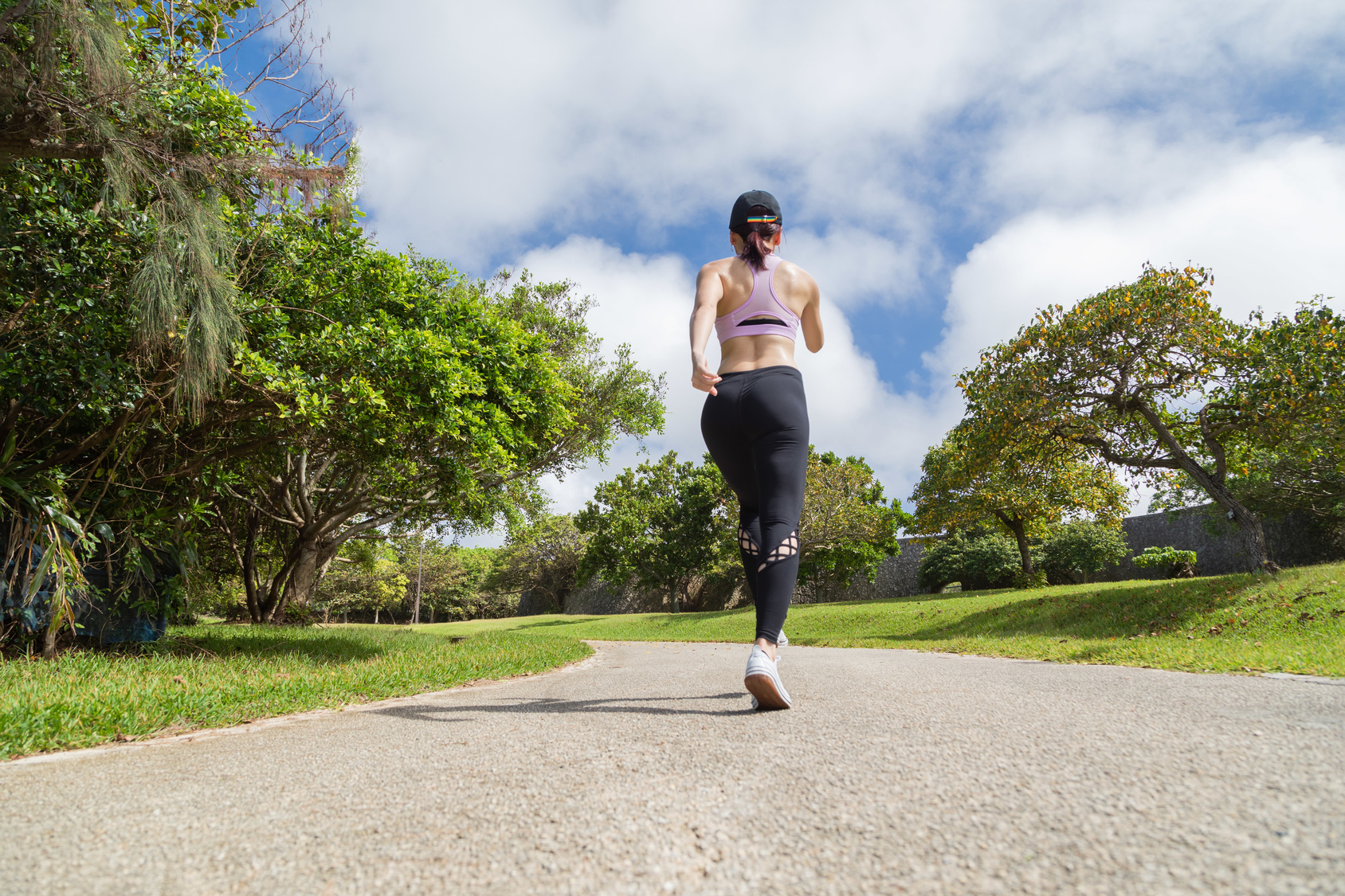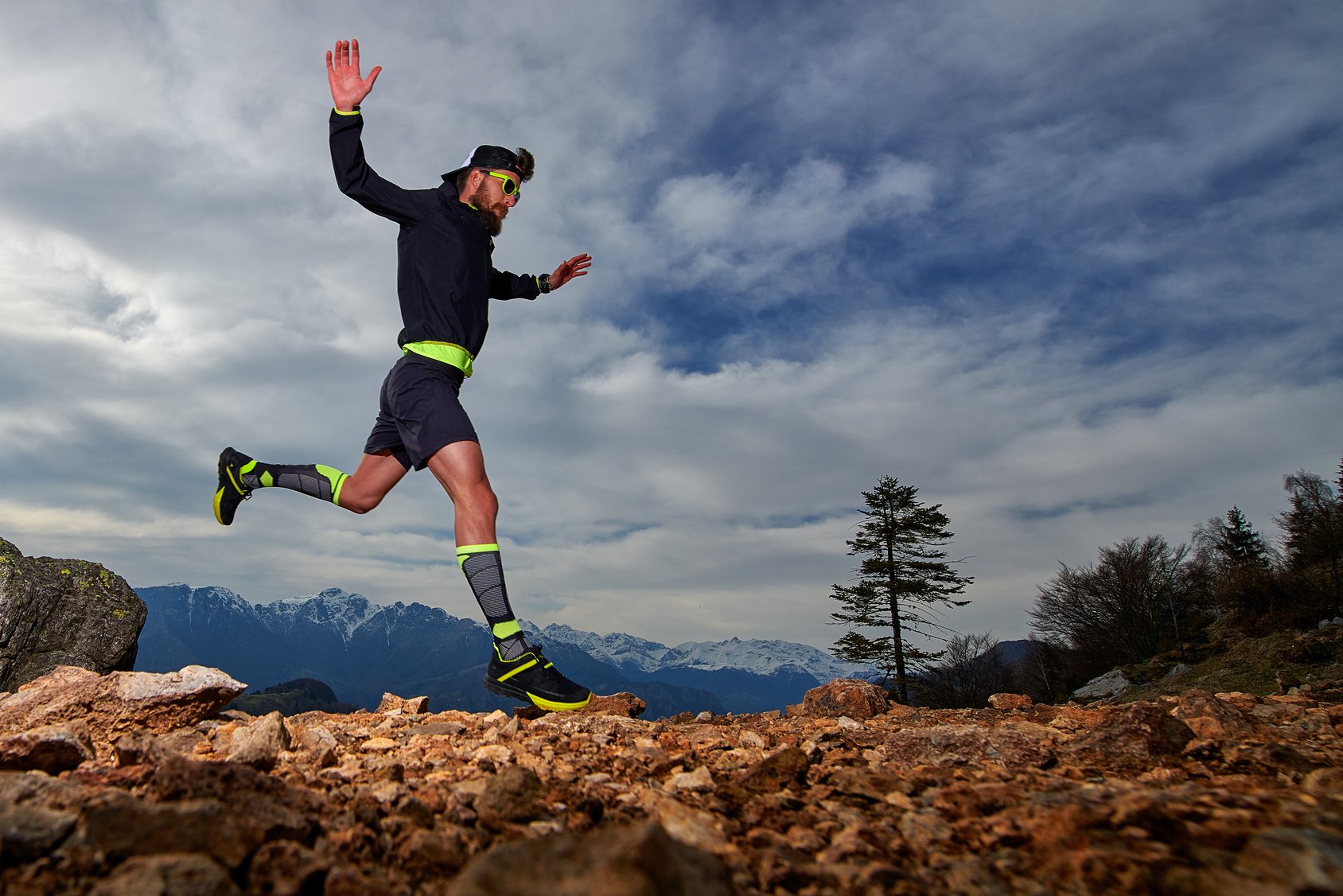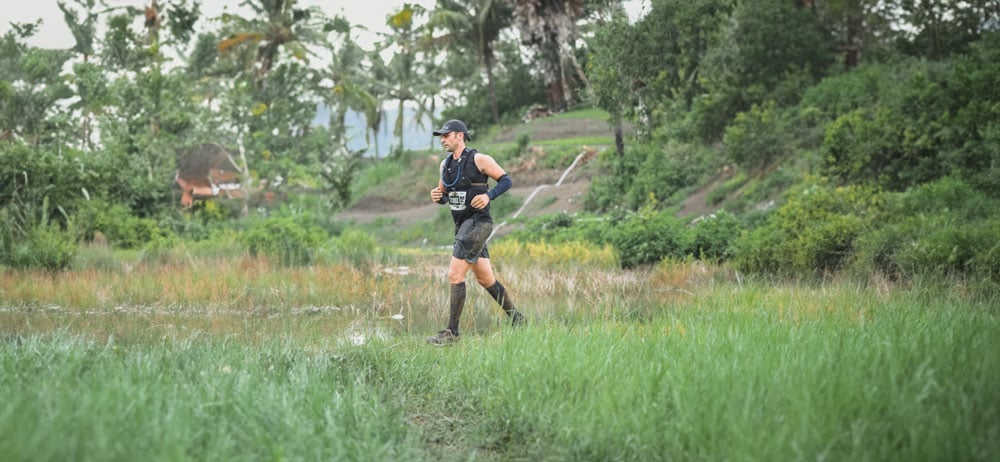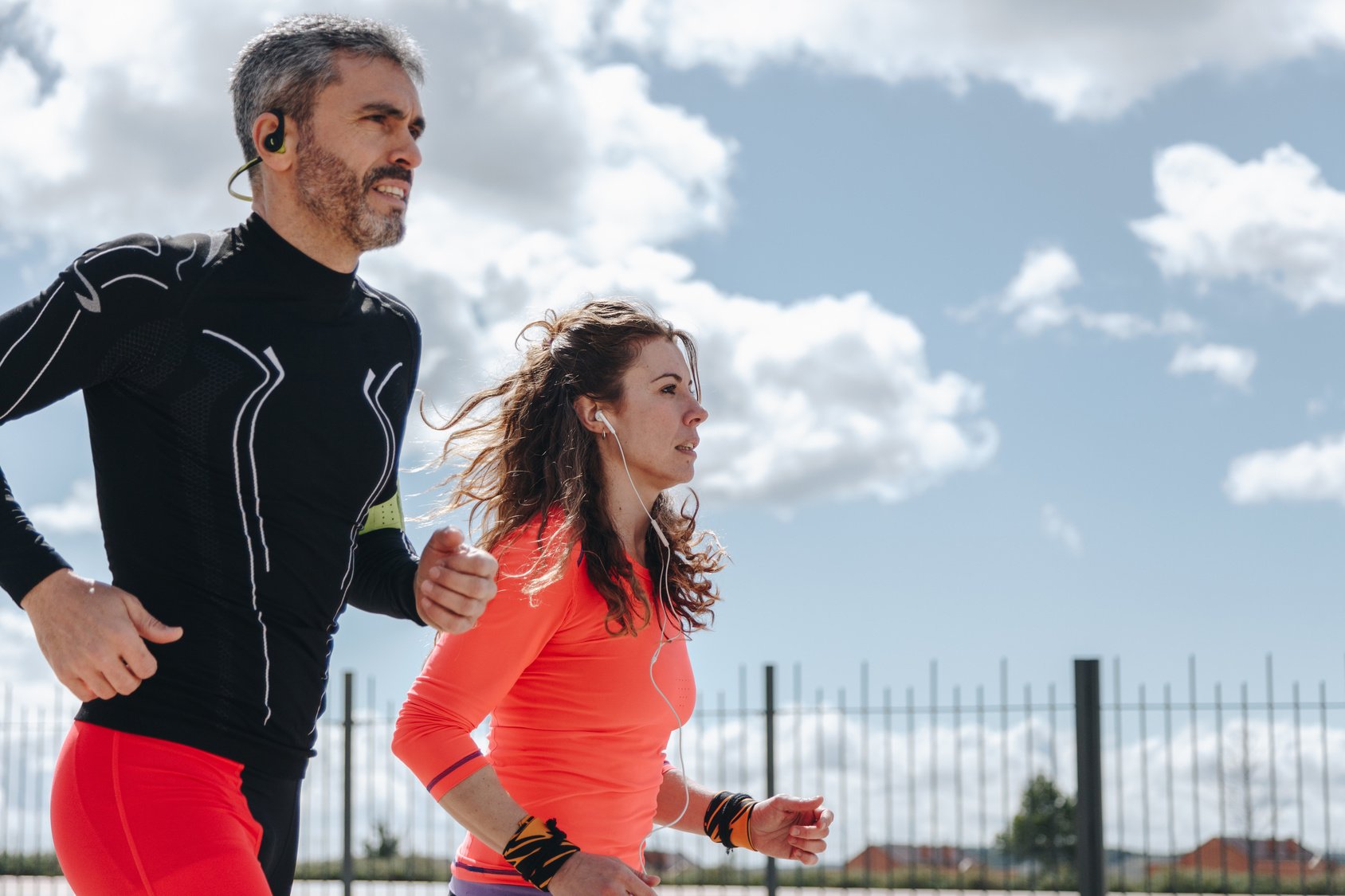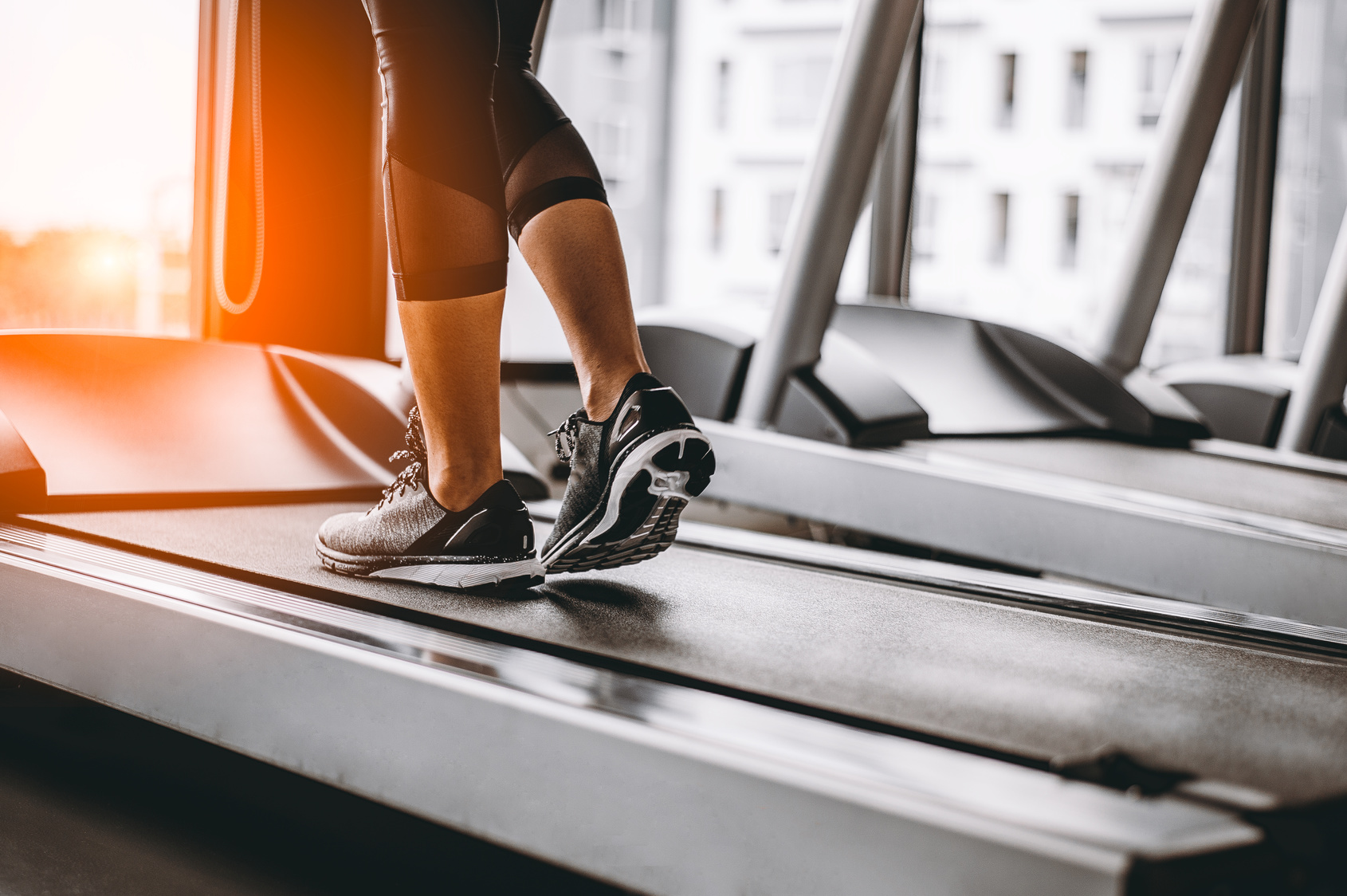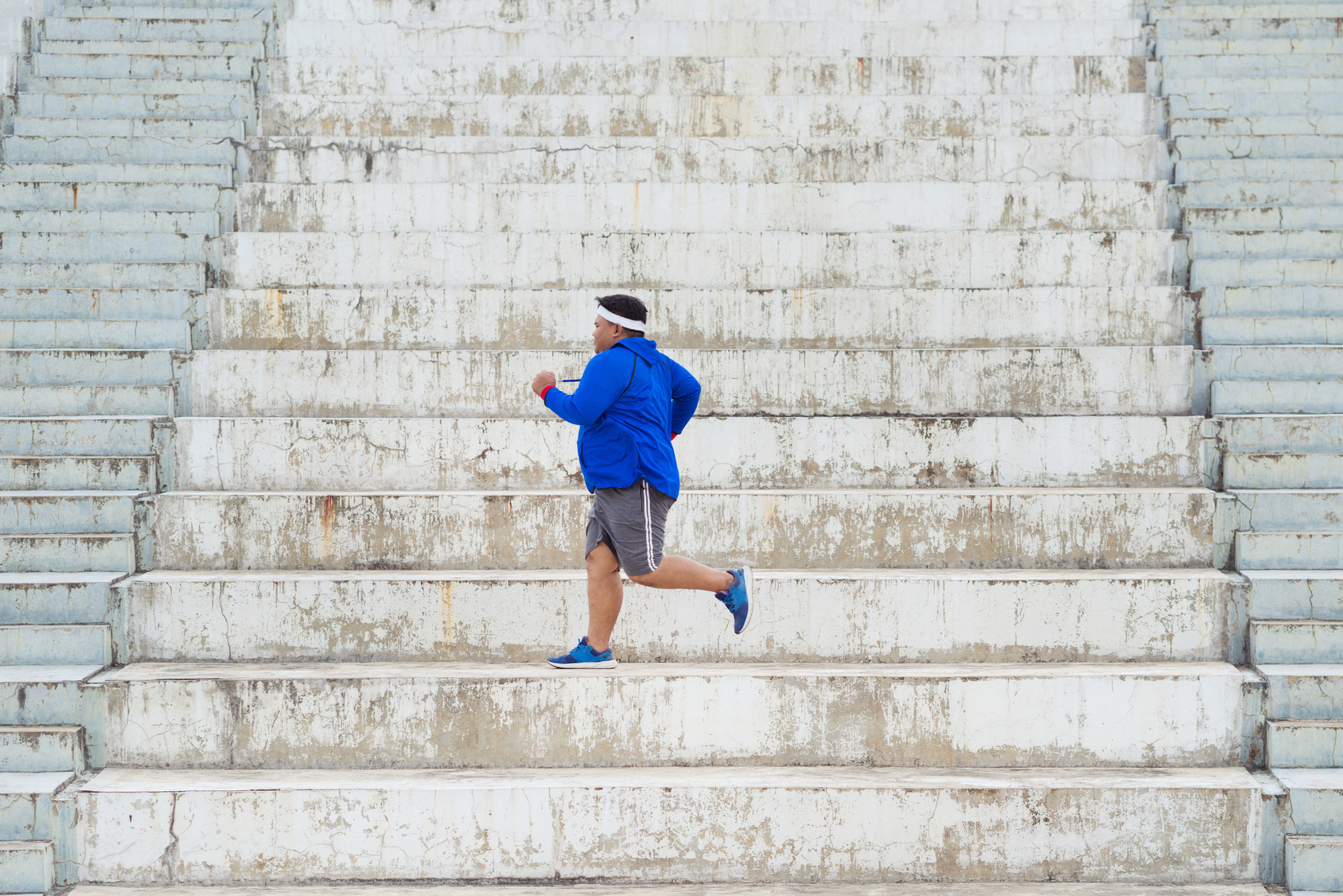Let’s be honest—running can sometimes feel like a never-ending battle against boredom. We’ve all been there, hitting that snooze button or contemplating skipping a run because, well, it just doesn’t sound like the most exciting thing to do.
But fear not! I’m here to inject some much-needed fun into your running routine. Because let’s face it, when you enjoy what you’re doing, you’re more likely to stick with it and crush those running goals.
So, let’s dive into the magical world of making running an absolute blast. Trust me, it’s possible!
Here are a few sneaky tricks that can turn your running sessions into exciting adventures:
Make Running Fun – 1. Get The Right Gear
Let’s start from the ground up—your feet. Ill-fitting running shoes are a recipe for disaster. Think blisters, black toenails, and even serious overuse injuries. We don’t want any of that, do we? So, invest in a pair of running shoes that are tailored to your feet, providing the perfect balance of support and cushioning. Trust me, your feet will thank you with every stride.
But gear isn’t just limited to shoes. Oh no, my friend, we’re talking about a complete ensemble here. Picture yourself in a breathable and waterproof shirt that keeps you cool and dry, no matter what Mother Nature throws your way. And let’s not forget about those pocketed leggings that let you stash your essentials (keys, phone, and maybe a few snacks for those extra-long runs). We’re talking about the ultimate running armor that keeps you comfortable and prepared for any weather condition.
Now, here’s the secret sauce to getting the best gear possible. Skip the run-of-the-mill sports shops you find on every corner and head straight to a specialist running store. These gems are filled with expert staff who are not only passionate runners themselves but also know their gear like the back of their hand. They’ll give you the royal treatment, providing personalized gait analysis to determine your unique running style and recommend the perfect gear that matches your needs. It’s like having a personal stylist for your running adventures!
Make Running Fun – 2. Slow Down
If you’ve ever laced up your sneakers, charged out the door at full speed, only to crash and burn moments later, you’re not alone. It’s a classic rookie mistake that can leave you feeling defeated and wondering if running is really worth all the hype. But fear not, my friends, because I’m here to guide you on the path to running success.
So, let’s talk about starting off on the right foot. The key is to ditch the sprint mentality and embrace a more balanced approach. Trust me, it’s all about finding your rhythm and building up your endurance gradually. Enter the walk/run method, a game-changer for beginner runners. Picture this: you alternate between easy jogging and walking, spending a minute on each.
Now, don’t let the simplicity of this method fool you. It’s a tried-and-true technique backed by science. Incorporating walking intervals into your running routine not only reduces the risk of injuries but also improves overall fitness.
As you progress in your training, it’s time to level up those intervals. Gradually increase the time you spend jogging while shortening your recovery periods. Before you know it, you’ll be breezing through 30 to 45-minute sessions without feeling like you’re gasping for air. But here’s the secret ingredient: pace yourself. There’s no need to be a speed demon during your runs. Stick to a conversational pace, where you can comfortably chat with a training buddy without feeling like you’re in a breathless race against the clock.
Here’s how to start running again.
Make Running Fun – 3. Set The Right Goals
Before you lace up those sneakers and embark on your running journey, it’s essential to have a clear idea of what you want to achieve. It’s like plotting your course on a running adventure map.
So, let’s ask ourselves some important questions.
First off, do you want to shed some pounds and embrace a healthier lifestyle? Maybe you’re aiming to improve your 5K timing and leave your personal records in the dust. Or perhaps you’re a parent looking to be a shining example of health and determination for your kids. Whatever your aspirations may be, it’s crucial to know your goals and set the right ones.
Setting goals is like giving your running journey a purpose. It becomes your guiding light, even when that sneaky inner voice tries to convince you otherwise. And here’s the best part: your running goals don’t have to be overly complicated or lofty. In fact, simplicity is key. It can be as straightforward as committing to run three times per week or shedding off those stubborn 15 pounds.
But hold on, my friends. Once you’ve mastered the basics and feel the burning desire to take your training to the next level, it’s time to elevate those goals. Get specific, get ambitious! Aim to conquer that elusive sub-30-minute 5K or complete a marathon in less than four hours. These targeted goals not only give you something exciting to strive for but also work wonders for your running motivation.
Now, let’s not forget that setting goals is just the beginning of your running adventure. The real magic happens when you combine them with passion, dedication, and a sprinkle of self-belief.
Make Running Fun – 4. Reward Yourself For The Tiniest Progress
Studies have shown that incorporating self-rewards into your running routine can work wonders for your motivation. And hey, who doesn’t love a little extra motivation, right?
Here’s the scoop: when you reward yourself after a run, or any other activity for that matter, your brain starts to associate that sweet pleasure with the very thing you just accomplished. It’s like training your brain to say, “Hey, running is pretty awesome! Let’s do more of that!” And that, my friends, increases your chances of success in sticking to your running goals.
Now, here’s the best part. Rewards don’t have to be extravagant or earth-shattering. You don’t need to climb Mount Everest or win an Olympic gold medal to celebrate your achievements. No, no, no. In fact, it’s the little victories that deserve the biggest celebration.
Did you push yourself a little further today? Celebrate it! Treat yourself to a long, well-deserved nap or indulge in a guilt-free binge-watching session of your favorite show. Maybe it’s time to spice up your running wardrobe with a shiny new outfit or invest in a pair of fresh, cushioned running shoes that make you feel like you’re flying. And hey, why not gather your running buddies and head out for a delicious dinner or enjoy a night at the movies?
The key is to find rewards that bring you joy and make you feel proud of your accomplishments, no matter how big or small they may be. So, my fellow runners, let’s celebrate every step, every milestone, and every sweaty victory along the way.
And remember, the power of rewards goes beyond just running. It applies to any habit you’re trying to build. So, whether you’re conquering the world one mile at a time or embarking on a new adventure, sprinkle some self-rewards along the way and watch as your motivation soars.
Make Running Fun – 5. Race
Listen up, my fellow running enthusiasts, because I’m about to share with you the transformative power of training for a race. Trust me, it’s a game-changer.
I remember the first time I decided to take on a race. It was a pivotal moment in my running journey. Suddenly, I felt like I had crossed a threshold and become a bona fide runner. It was a thrilling realization that ignited a fire within me.
Now, here’s the thing: you can’t just sit around twiddling your thumbs, waiting for the perfect race to magically appear. No, my friend, you’ve got to take matters into your own hands. It’s time to dive headfirst into the exhilarating world of racing.
So, I challenge you to step up and register for a race. Any race that tickles your fancy and gets your heart racing with anticipation. There’s a plethora of options out there just waiting for you to seize them.
Feeling adventurous? How about tackling a muddy, adrenaline-pumping mud run that will test your strength and endurance? Or perhaps you’re up for conquering a series of challenging obstacles that push your limits in an obstacle race. If you crave the serenity of nature, why not immerse yourself in the beauty of a trail race, where every step is a breathtaking adventure? And for those who dare to go the extra mile, literally, there are ultra distances that will take you on an awe-inspiring journey, spanning from 50 kilometers to mind-boggling 100-mile feats of endurance and beyond.
The options are endless, my friends. So lace up your running shoes, channel your inner adventurer, and embark on a race that will leave you feeling invigorated, accomplished, and hungry for more. Trust me, there’s nothing quite like the rush of crossing that finish line, surrounded by fellow runners who have shared the same exhilarating journey.
You can also train for a sub 20 5K race.
Make Running Fun – 6. Change up Your Running Routine
Picture this: you’re lacing up your running shoes, ready to hit the pavement or trail, but something feels off. The excitement and joy of running seem to have taken a temporary leave of absence. Don’t fret, my friend, because I’ve got a simple yet powerful solution for you: it’s time to explore new running routes and let the winds of change blow through your running routine.
Let’s face it, running on the same old path day in and day out can become monotonous and drain the spark that initially ignited your love for the sport. But fear not, because there’s a world out there waiting to be discovered, one stride at a time.
Imagine embarking on an open road, uncharted territory for your running adventures. Or how about diving into a new trail, where each step reveals a hidden treasure of natural beauty? If you’re lucky, you might even stumble upon a state park that offers a breathtaking backdrop for your runs, with scenic vistas and tranquil surroundings that transport you to a runner’s paradise.
Why is exploring new running routes so crucial? Well, let me tell you, my fellow runner, it’s all about injecting a sense of novelty and adventure into your workouts. When you step onto unfamiliar terrain, something magical happens. Your senses awaken, your curiosity piques, and suddenly, running becomes an exploration—an exhilarating journey of discovery.
But here’s the secret ingredient: don’t let routine settle in. Keep the excitement alive by regularly changing your running routes. Embrace variety like a connoisseur of adventure. Seek out different neighborhoods, scenic trails, urban landscapes, and picturesque parks. Let each run be a unique experience, a chapter in your ever-evolving running story.
And guess what? This approach isn’t just about fun and enjoyment; it’s backed by science too. A study published in the Journal of Environmental Psychology by Pretty et al. (2005) found that exposure to natural environments during exercise has significant positive effects on mental well-being, reducing stress and enhancing mood. So, by exploring new running routes that immerse you in the beauty of nature, you’re not only enlivening your runs but also nourishing your mind and soul.
Make Running Fun – 7. Take a Break
Now, I know what you’re thinking—taking a break from something you love sounds counterintuitive. But trust me when I say that sometimes, a little time apart can work wonders for the soul. Think of it like a bittersweet separation that ultimately strengthens the bond. It’s like stepping back to catch your breath, allowing yourself to miss the rhythmic pounding of the pavement and the exhilarating wind rushing through your hair.
Absence truly has a magical effect, my friend. When you step away from running, even for a short while, you give yourself the opportunity to appreciate it in a whole new light. It’s like rediscovering an old flame or reconnecting with a long-lost friend. That spark that once ignited your love for running might just reignite with a renewed vigor and excitement.
But let’s be real for a moment. If the time spent apart from running doesn’t reignite that fire within you, it might be time to embark on a new adventure. Don’t worry, it’s not a betrayal of your running journey; it’s simply an opportunity for growth and exploration. Sometimes, our passions evolve, and that’s okay. Life is too short to stick with something that no longer brings us joy.
But before you make any hasty decisions, allow me to offer a word of caution. Research suggests that taking breaks from our regular activities can actually improve performance and motivation when we return to them. A study published in the Journal of Applied Sport Psychology by Iso-Ahola and Mobily (1980) found that intermittent breaks from training can lead to increased levels of motivation and enjoyment in athletes.
Make Running Fun – 8. Try A Running Streak
When I mention streaking, I definitely don’t mean stripping down and sprinting through town in your birthday suit. Let’s keep things legal and avoid any unwanted encounters with the law. I’ve got your back, and I certainly don’t want you behind bars because of me!
In the running world, streaking takes on a whole different meaning. It’s all about running on consecutive days, building a streak that lasts for an extended period of time. Think of it as a thrilling challenge that pushes your dedication and commitment to the limits. I’ve personally embarked on this streaking journey myself, and let me tell you, it was quite the experience. My longest streak lasted a solid two months, and boy, did it leave me with a sense of accomplishment.
Now, let’s talk about your streaking goal. It’s simple, really. Aim to run at least a mile every single day for three whole months. That’s right, no excuses, no days off. As the weeks progress, gradually increase the duration of your daily runs. Add an extra 5 to 10 minutes here and there until you find yourself pounding the pavement for a solid hour or more. It’s all about pushing your boundaries and embracing the challenge.
But wait, there’s an important caveat to keep in mind. Before you dive headfirst into a streaking routine, you need to ensure that your body is ready for the increased load. It’s crucial to have a solid foundation of training mileage under your belt. This means you should already be comfortably handling a moderately high training workload. This preparation will help your body adapt and minimize the risk of injury—because trust me, the last thing you want is to be sidelined due to an avoidable mishap.
Here’s how long does it take to run 3 miles a day.
Make Running Fun – 9. Stay in The Moment
Now, I know what you might be thinking—this advice might sound like something straight out of a mystical, new age gathering. But hold on a second, because there’s actually some truth to it. It’s not all woo-woo nonsense. In fact, the concept of living in the present moment has been backed by scientific studies and proven to have tangible benefits.
So, how do you practice this art of being present? It all starts with setting the right mindset. Take a deep breath, clear your mind of any distractions, and stand tall with confidence. Allow your body to relax, and consciously set your intention on staying fully present in the moment. It’s like stepping into a powerful state of mindfulness.
Now, let’s turn our attention to the world around us. Engage your senses and become aware of every little detail in your surroundings. Feel the rhythm of your movements, the way your body gracefully propels you forward. Notice the temperature on your skin, the gentle caress of the wind against your face. Become attuned to the elements, embracing the raw beauty of nature as you run.
But we’re not stopping there. It’s time to fully immerse yourself in the present moment. Engage all your senses, one by one. Take in the scents that surround you—the earthy aroma of the forest, the crisp freshness of the morning air. Listen to the symphony of sounds, from the rhythmic beat of your footsteps to the harmonious melody of birdsong. Embrace it all, allowing yourself to become fully present and connected to the world around you.
By practicing this mindful approach to running, you tap into a deeper level of engagement and enjoyment. You’ll find that every stride becomes a conscious act, a meditation in motion. The worries of the past and the anxieties of the future melt away, leaving you with a sense of peace and fulfillment in the present.
Make Running Fun – 10. Give it Time
Let’s talk about the secret ingredient to making running more fun: time. Just like building a solid and fulfilling relationship, it doesn’t happen overnight. You can’t rush the process and expect magical transformations to occur in an instant. It’s all about the long game, my friend—a commitment filled with ups and downs, just like a real relationship.
You see, running is a journey, a beautiful and ever-evolving adventure that requires patience and perseverance. Time becomes the true judge of whether your running routine will flourish and meet your expectations.
Now, I won’t sugarcoat it—there will be moments when running feels like a struggle. It’s during these challenging times that you must resist the temptation to give up and instead embrace the opportunity for growth. It’s normal to face setbacks and obstacles along the way, but it’s how you navigate through them that truly matters.
Think of your running journey as a rollercoaster ride—a thrilling mix of highs and lows. Sometimes you’ll feel on top of the world, effortlessly gliding through your runs with a smile on your face. Other times, you may encounter roadblocks that make you question your love for running. But remember, these are just temporary bumps in the road.
So, what can you do when your running routine isn’t living up to your expectations? First, be open to trying different things. Explore new routes, experiment with various training methods, and inject some excitement into your routine. Change things up and see what sparks your passion. Remember, variety is the spice of life, and the same goes for running.
It’s also crucial to periodically reassess your goals. Are they still aligned with your current desires and aspirations? If not, it’s okay to pivot and set new targets that excite you. Allow yourself the freedom to evolve and grow as a runner. Your goals should reflect your personal journey, motivating and inspiring you along the way.
Here’s how to overcome your running excuses.
Make Running Fun – 11. Get a Running App
Let’s dive into the exciting world of running apps that can turn your ordinary runs into extraordinary adventures. The best part? Many of these apps won’t break the bank, and some are even free! So, get ready to discover a whole new level of fun on your runs.
Picture this: you’re lacing up your running shoes, and your trusty running app is at your fingertips, ready to enhance your running experience. These apps are more than just run trackers—they’re your virtual companions, inspiring coaches, and even protectors of your safety. They’ve got your back every step of the way.
First up, we have the legendary Couch to 5K app. This gem has earned its place among the running community’s favorites. If you’re starting from ground zero and dreaming of becoming a true runner, look no further. Couch to 5K will guide you through three 30-minute sessions per week, gradually building your stamina and preparing you to conquer a 5K race within two months. It’s like having a personal running coach right in your pocket.
Now, brace yourself for an epic adventure with Zombies, Run! This app takes your runs to a whole new level by immersing you in the middle of a post-apocalyptic zombie world. As you jog along, the app provides thrilling stories and missions for you to listen to and complete. It’s like stepping into an action-packed movie while burning those calories. Get ready to outrun those zombies and save humanity!
For all you music enthusiasts out there, Rock My Run is an absolute must-have. This app curates the best workout music playlists to fuel your runs with high-energy beats. Say goodbye to monotony and hello to a rockin’ pace that keeps you grooving and motivated mile after mile. Let the rhythm guide your steps and unleash your inner music superstar.
Now, if you’re a running nerd like me who craves every detail of your running performance, Runtastic is the app for you. It goes beyond basic tracking, providing a more detailed approach to your runs. From duration and distance to elevation gain, speed, and calories burned, Runtastic leaves no stone unturned. It’s like having your own personal data analyst, helping you geek out over every aspect of your runs.
Make Running Fun – 12. Run at Night
Hold on tight, because we’re about to dive into a topic that might raise a few eyebrows. Are you ready for it? Brace yourself, my adventurous friend. We’re talking about the exhilarating world of night running!
Now, I know what you’re thinking. Night running? Are you crazy? Well, hear me out. While it may not be everyone’s cup of tea, there’s something truly magical about hitting the pavement when the moon is high and the stars are shining bright. It’s like stepping into a different realm, where the world takes on a whole new dimension.
But hey, safety first, right? We don’t want you stumbling around in the dark, running into lampposts like a clumsy cartoon character. So, let’s cover some important precautions to ensure you have a safe and enjoyable nighttime running experience.
First things first, choose your running routes wisely. Opt for well-lit areas with plenty of visibility, preferably where there’s some activity going on. It’s all about finding that sweet spot between adventure and safety. And speaking of safety, make yourself visible! Wear reflective gear that shines like a beacon in the night, making you impossible to miss. You can even go all out and rock a headlamp like a superhero illuminating the path ahead.
Now, let’s talk about an extra layer of precaution—personal safety tools. Consider carrying a trusty pepper spray, just in case you encounter any unsavory characters. It’s like having a secret weapon in your running arsenal, ready to fend off any unwanted advances. And hey, there’s strength in numbers, right? Don’t hesitate to team up with a running buddy or join a running group. Not only does it add a sense of camaraderie, but it also provides an extra layer of protection. Together, you’ll conquer the night like a fearless wolf pack.
Remember, night running isn’t for everyone, and that’s perfectly okay. If it’s not your cup of tea or if you have concerns about safety, stick to the daylight hours. But if you’re seeking a thrilling adventure that pushes your boundaries and ignites your senses, why not give it a try? Just make sure to take the necessary precautions, follow our safety tips, and trust your instincts.
Here’s the full guide to safe outdoor running.
Make Running Fun – 13. Run Naked
Listen up, my fellow running enthusiast. I’m about to share a secret that might make your running experience a whole lot more intimate and personal. Brace yourself, because we’re talking about the liberating act of running “naked.” Now, and yet again, before your mind goes off to a scandalous place, let me clarify. We’re not talking about shedding your clothes in public (that would be quite the spectacle!). We’re talking about running without the usual gadgets and gizmos that usually accompany us on our runs.
Picture this: it’s just you and the open road, with nothing but the sound of your own footsteps and the rhythm of your beating heart. No distractions, no external influences—just pure, unadulterated connection with yourself and the sport you love. Running “naked” is all about stripping away the layers of technology and embracing the simplicity of the run.
Now, I know what you’re thinking. No music? No GPS tracking? Are you crazy? Well, hear me out. By leaving your music playlist and GPS watch at home, you’re embarking on a new kind of journey—one that’s fueled by inner motivation and self-discovery. It’s a chance to reconnect with the essence of running and truly listen to your body, mind, and soul.
Research has shown that running without external distractions can lead to a deeper sense of self-awareness and improved focus during your workout. Instead of constantly checking your pace or being lost in the beats of your favorite tunes, you’ll find yourself fully present in the moment, attuned to every sensation and nuance of your run.
Running “naked” allows you to tap into your internal compass and set your own pace. You become your own competition, striving to beat your personal records and surpass your own expectations. It’s a chance to embrace the purity of the sport and remind yourself why you fell in love with running in the first place.
Additional resource – How to Do a Run Streak
Make Running Fun – 14. Buddy Up
Running solo can sometimes feel like a solitary journey, a lone wolf navigating the trails. But when you have a running buddy by your side, it’s like joining forces with a fellow adventurer, embarking on a quest together. Not only does it make the miles fly by faster, but it also adds a whole new layer of excitement and camaraderie to your runs.
Research has shown that training with a partner can significantly increase your adherence to a training program. When you have a running buddy waiting for you at the starting line, you’re much more likely to lace up your shoes and show up, rain or shine. It’s a built-in accountability system that keeps you committed and motivated.
But it’s not just about the practical benefits. Training with a friend opens up a world of possibilities. Together, you can conquer new running routes, explore uncharted trails, and discover hidden gems in your running playground. It’s like having a sidekick to share the adventure with—a true companion who understands your passion for running.
And let’s not forget the social aspect. While pounding the pavement, you can chat about anything and everything under the sun. From the latest episode of your favorite TV show to the intricate details of your favorite running shoes, the conversation flows effortlessly. It’s a chance to connect on a deeper level and forge lasting friendships.
Now, I know approaching other runners might feel a bit daunting at first. But trust me when I say that most runners are just as eager to find a running buddy as you are. Don’t be shy! Strike up conversations at local running events, join running clubs in your area, or leverage the power of online running communities to find your perfect match. Remember, if you don’t ask, the answer will always be no.
Make Running Fun – 15. Watch TV on the Treadmill
Picture this: You hop on the treadmill, ready to conquer your run, but as the minutes tick by, you find yourself caught in a vortex of boredom. The monotonous rhythm of your footsteps feels like a never-ending loop, and you start daydreaming about being anywhere else but on that treadmill. But fear not, my friend, because I have a game-changing solution that will turn your treadmill sessions into a delightful escape.
Are you ready for it? It’s time to bring some entertainment into the mix—television, to be precise. Yes, you heard me right. We’re about to combine the power of television with the sweat-inducing magic of the treadmill. Trust me, it’s a match made in workout heaven.
Research has shown that watching television during exercise can help reduce feelings of fatigue and boredom, making your treadmill runs more enjoyable and even increasing your endurance.
Now, when it comes to choosing the perfect TV show for your treadmill escapades, it’s all about finding the right balance. For shorter runs, opt for humor-packed shows that can bring a smile to your face and keep your spirits high. The witty banter of “The Big Bang Theory,” the hilarious adventures of “Amy Schmidt,” or the irreverent humor of “BoJack Horseman” can be just the fuel you need to power through those quick bursts of cardio.
But when it’s time to tackle those longer runs, it’s all about drama and intrigue. Dive into the world of gripping police shows like “The Blacklist” or get lost in the thrilling adventures of “The Flash.” These shows will keep your mind engaged and distracted from the physical exertion, allowing you to push your limits and conquer those distance goals.
Need more structure for your treadmill workout?
Try my Couch to 5K treadmill plan.
Make Running Fun – 16. Listen to Music
Music has the power to uplift our spirits, fuel our determination, and transport us to a whole new level of performance. As a fellow music aficionado, I understand the importance of selecting the perfect tunes to accompany our runs, and believe me, it’s an art form in itself.
Just like a well-curated playlist can set the tone for any occasion, choosing the right running music is key to optimizing our workouts. It’s all about syncing your tunes with your mood and purpose. When I’m gearing up for some high-intensity workouts or exhilarating interval sessions, I crave the pulsating beats and electrifying energy of my high-energy playlist. It’s like strapping rocket boosters to my running shoes and propelling myself forward with every beat.
But on those recovery days or during long, soul-soothing runs, I switch gears and dive into the soothing melodies and laid-back rhythms of my relaxed playlist. It’s a musical sanctuary that helps me find my flow, escape the chaos of the world, and embrace the therapeutic power of running.
And guess what? Science has our backs on this one! Research conducted at the esteemed Brunel University in London revealed that exercising while listening to music can significantly enhance our performance. The study found that subjects who rocked out to their favorite tunes during their workouts were able to run farther, swim faster, and bike longer than those who exercised in silence. Talk about the undeniable impact of music on our physical capabilities!
Now, here’s a pro tip: To truly harness the power of music, it’s important to pay attention to the tempo and groove of the songs you choose. The right beats per minute (BPM) can synchronize with your stride and create a harmonious rhythm that propels you forward effortlessly. That’s where playlists organized by BPM come into play. Apps like Tempo Run and RockMyRun are like our personal DJs, handpicking tracks that match our desired tempo and keep us in the zone throughout our runs. It’s like having a virtual coach and a musical curator all in one.
Make Running Fun – 17. Try a Podcast
Podcasts have taken the digital airwaves by storm, and lucky for us, there’s an abundance of running-related podcasts that can elevate your running experience. With just a simple Google search, you’ll uncover a treasure trove of shows dedicated to the sport we love. From expert advice on training techniques to fascinating stories of endurance and triumph, these podcasts are like having a personal coach and a running community in your earbuds.
But don’t limit yourself solely to running podcasts. The beauty of this medium is its vast diversity of topics and genres. Expand your horizons and explore a wide range of podcasts that pique your interest. Personally, I’m a big fan of the 4-Hour Workweek blogger, Tim Ferriss. His captivating podcast delves into the realms of fitness, health, adventure, finance, startups, and everything in between. It’s like having a brilliant conversationalist by your side, feeding your mind while you conquer the miles.
Now, let’s not forget about the power of audiobooks. If you crave a deeper immersion into a captivating narrative or wish to expand your knowledge while you run, audiobooks are your gateway to a literary adventure. Lose yourself in a gripping thriller, dive into a thought-provoking non-fiction book, or even indulge in a classic piece of literature.
Additional resource – What’s the best temperature for running
Make Running Fun – 18. Try Fartlek
Originating from the land of the Vikings, this Swedish training method, aptly named “speed play,” adds a touch of excitement and spontaneity to your workouts. It’s like dancing through the streets with the wind at your back, chasing fleeting targets and reveling in the rush of speed.
So, how does one embark on this exhilarating journey of Fartlek? Let me guide you through the steps:
Warm up: Always start with a proper warm-up to awaken those muscles and prepare your body for the bursts of speed that lie ahead. A few minutes of light jogging, dynamic stretches, and mobility exercises will do the trick.
Set your sights: Now, fix your gaze upon a captivating object in the distance. It could be a lamppost, a passing cyclist, a meandering squirrel, or even the end of the block calling out to you. Choose your target wisely, for it shall be your guide.
Sprint like the wind: Release your inner cheetah and dash towards your chosen target with all the vigor and velocity you can muster. Feel the power surging through your legs, propelling you forward like a shooting star in the night sky. Embrace the exhilaration, my friend.
Recover and repeat: Once you reach your target, ease off the accelerator and allow yourself to recover. Take a moment to catch your breath, relish in the triumph of the sprint, and then set your sights on the next object that beckons you. This could be a few meters ahead, around the bend, or wherever your adventurous spirit leads you.
Rinse and repeat (if you dare): Keep repeating this delightful dance of speed and recovery until your legs whisper, “No more, please!” Push your limits, challenge yourself, and relish in the dynamic rhythm of Fartlek.
Make Running Fun – 19. Add Bodyweight Exercises to Your Run
prepare to take your runs to a whole new level with the power of hybrid workouts. By infusing your running routine with bodyweight exercises, you’re about to embark on a thrilling journey of strength, stamina, and a touch of CrossFit flair. Get ready to experience the best of both worlds!
Imagine this: as you hit the pavement, each step propelling you forward, you’re not just running, but engaging your entire body in a symphony of movement. It’s like adding a pinch of spice to a gourmet dish, enhancing the flavor and elevating the experience. Let me guide you through the exhilarating process:
- Spice up your run: As you embark on your run, break the monotony by incorporating bodyweight exercises at regular intervals. This not only keeps things exciting but also provides a wonderful opportunity to enhance your strength and endurance.
- The do-anywhere moves: Picture this: while basking in the glory of nature’s embrace, pause every five minutes of running to perform dynamic bodyweight exercises. Think push-ups to engage your chest and triceps, squats to strengthen those legs, and pulse lunges to target your lower body with a fiery intensity. Feel the burn, my friend!
- Jump into the rhythm: To add an extra touch of cardio intensity, why not include a few minutes of jump roping during your run? Grab that trusty skipping rope and let it whirl through the air as you jump with vigor. It’s like dancing to the beat of your own fitness symphony, as your heart pounds and your body soars.
- The CrossFit infusion: Now, here’s where the magic truly happens. By blending these bodyweight exercises and jump roping into your run, you’re infusing it with a sprinkle of CrossFit essence. CrossFit, known for its high-intensity workouts, helps you build strength, agility, and all-around fitness. So why not bring that same dynamic energy into your runs?
Studies and research back this approach, my friend. According to a study published in the Journal of Strength and Conditioning Research, incorporating bodyweight exercises into running can improve running economy and performance. It’s a win-win situation!
Make Running Fun – 20. Try Hill Reps
Hill training is a vital ingredient in every runner’s recipe for success, whether you’re a casual jogger or a top-tier athlete. Prepare yourself for an exhilarating journey that will push your limits and elevate your running prowess to new heights.
Imagine this: standing at the base of a mighty hill, its slope reaching towards the heavens, beckoning you to take on the challenge. It’s like standing at the foot of a mountain, ready to conquer the summit and embrace the rewards that await you
Seek out the perfect hill: Your first task is to locate a long hill that will put your endurance and strength to the test. Picture a hill that stretches out before you, demanding at least five minutes of effort to conquer its summit. This will become your training ground, your playground for growth and achievement.
- Warm-up and prepare: Before embarking on your uphill adventure, it’s crucial to prepare your body for the challenge ahead. Engage in a dynamic warm-up routine, ensuring your muscles are primed and ready for action. Think leg swings, lunges, and gentle jogging to get the blood flowing and awaken your inner running beast.
- Ascend with purpose: Now, my friend, it’s time to tackle the hill with determination and grace. Start your ascent at a sustainable pace, allowing the incline to ignite the fire within you. Feel the burn in your legs, the power surging through your body as you conquer each step. You’re building strength and resilience with every stride.
- Recover and reset: As you reach the pinnacle of the hill, take a moment to catch your breath, allowing your body to recover. It’s like standing on a mountaintop, gazing at the breathtaking view, savoring the achievement of reaching new heights. Then, turn around and gracefully descend, allowing your body to recharge and prepare for the next ascent.
- Rinse and repeat: Embrace the cycle of challenge and recovery as you repeat this exhilarating sequence. Conquer the hill three to five times, or until your body tells you it can do no more. Each repetition is a testament to your tenacity, your determination to push beyond your limits and unleash your true potential.
But wait, my friend, there’s more! Research studies have shown the incredible benefits of hill training. A study published in the Journal of Strength and Conditioning Research revealed that hill training improves running economy, leg strength, and power. It’s like injecting your running routine with a dose of turbocharged performance.
For more, learn how to design your own running program.
Make Running Fun – 21. Smile While Running
Did you know that your smile has the magical ability to trick your brain into releasing those wonderful feel-good chemicals? It’s true! Research has shown that by simply faking a smile, you can stimulate the release of endorphins and serotonin, the happiness superheroes that can elevate your mood and bring about feelings of euphoria. It’s like performing a secret handshake with your brain to unlock a state of bliss.
But wait, there’s more! Smiling doesn’t just work its magic on your brain. It also has a profound impact on your body’s response to stress. Studies have shown that flashing a genuine smile can actually decrease recovery time from stressful situations and lower your heart rate. It’s like having a superpower that helps you bounce back from life’s challenges with grace and ease.
Now, let’s put this science-backed knowledge into action, shall we? It’s time to embrace the power of the smile and make it a part of your daily routine. Here’s a simple yet powerful practice to incorporate into your life:
As you embark on your daily adventures, whether it’s a brisk morning walk, a jog in the park, or a stroll through your neighborhood, make it a habit to greet every person you pass with a warm and heartfelt gesture. It could be a nod of acknowledgment, a cheerful “good morning,” or a big, genuine smile that radiates positivity.
Think of it as spreading little pockets of sunshine wherever you go. Imagine yourself as the beacon of happiness, illuminating the paths of those you encounter. Your smile can brighten someone’s day, lift their spirits, and create a ripple effect of joy in the world around you.
Make Running Fun – 22. Do a Ladder Workout
Let’s take your interval workouts to the next level with a ladder workout. It’s like embarking on a climbing adventure where you challenge yourself to reach new heights of speed and distance. Get ready to push your limits and witness your progress unfold before your eyes.
The concept of a ladder workout is simple yet incredibly effective. Just like climbing a ladder, you’ll be ascending and descending in both speed and distance as the workout progresses. It’s a thrilling way to add variety and intensity to your training routine, keeping you engaged and constantly pushing your boundaries.
Now, let’s break it down and get into the nitty-gritty of how to conquer this ladder workout:
Start with a solid 10-minute dynamic warm-up to prepare your body for the exhilarating challenge that lies ahead. Mobilize those joints, activate those muscles, and get your heart pumping.
Picture yourself standing at the foot of a metaphorical ladder, ready to climb. Begin by sprinting 100 meters with all your might, pushing yourself to a faster pace than the previous interval.
Once you’ve completed that 100-meter sprint, take a moment to catch your breath and recover. Jog or walk for about 100 to 200 meters, allowing your body to recharge and prepare for the next ascent.
Now, it’s time to climb higher. Challenge yourself with a 300-meter sprint, feeling the adrenaline coursing through your veins as you push your limits even further. Remember, each interval should be faster than the one before.
Take another recovery jog or walk to restore your energy and focus. Breathe deeply and embrace the anticipation of the next challenge that awaits you.
As you continue your ladder ascent, increase the distance with each interval. Run 400 meters, then 500 meters, and keep going until you reach your peak performance or until you can’t go any further.
Make Running Fun – 23. Run to Your Favorite Restaurant
Alright, let’s talk about a little guilty pleasure that we runners sometimes deserve—indulging in a delicious treat after a hard-earned run. Now, before you raise an eyebrow, let me explain why I’m making an exception this time.
Research has shown that incorporating rewards into our routines can actually boost motivation and help us stick to our fitness goals in the long run. And what better way to reward yourself than with a tantalizing food adventure?
Here’s the plan: choose a food or snack spot that has been lingering on your foodie radar, a place that has tempted your taste buds and made your mouth water just at the thought of it. It could be that trendy burger joint, that artisanal ice cream parlor, or even a cozy bakery with heavenly pastries. The choice is yours!
Now, let’s add an element of excitement to this culinary escapade. Plan your running route so that it leads you directly to your desired food destination. Picture it like embarking on a flavorful treasure hunt, with each step bringing you closer to a mouthwatering reward.
As you tie your shoelaces and start your run, imagine the anticipation building up inside you. With each stride, you’re not only burning calories and strengthening your body, but you’re also building up an appetite for the feast that awaits you. It’s like a metaphorical journey where your running becomes the bridge that connects you to the flavors you crave.
Alternatively, if you prefer to have a home-cooked or ordered meal waiting for you, go ahead and prepare it in advance. Picture yourself returning home after a satisfying run, greeted by the aroma of your favorite dishes. It’s like a celebration of your accomplishments, a symphony of flavors that reward your efforts.
Now, I must emphasize the importance of making mindful choices when it comes to your post-run indulgence. While it’s tempting to dive into a mountain of greasy fast food, let’s opt for a healthier approach. Choose nourishing options or even explore the realm of homemade meals. It’s amazing how you can recreate your favorite flavors using wholesome ingredients.
As for me, I have a weakness for Indian cuisine. The aromatic spices, the vibrant colors, and the explosion of flavors—it’s a culinary journey that never fails to captivate my taste buds. From savory curries to fragrant biryanis, the possibilities are endless. But remember, the choice is entirely yours. Find the cuisine that speaks to your soul and satisfies your cravings.
Make Running Fun – 24. Try Motion Meditation
Imagine this: You’re out on a run, feeling the rhythm of your footsteps, the gentle breeze brushing against your skin, and the world around you seemingly fading away. In this moment, you have the opportunity to not only connect with your body but also with your mind in a way that transcends the ordinary. How? By incorporating meditation into your running practice.
Research has shown that combining running with meditation can have remarkable benefits for both your mental and physical well-being. It’s like finding the perfect harmony between your mind and body, allowing you to experience a state of focused tranquility while you conquer the miles.
You see, running itself has a meditative quality. The repetitive motion, the cadence of your breath, and the steady rhythm of your stride can create a sense of flow and inner calm. It’s like a moving meditation, where each step becomes a gateway to a deeper connection with yourself.
If you’re unsure about how to integrate meditation into your running routine, fear not! There are resources available to guide you on this enlightening journey. Leo, from the Zen Habits Blog, has shared valuable insights on Zen Running, offering practical tips and techniques to help you find that elusive state of mindfulness while you’re on the move. It’s a treasure trove of wisdom that can transform your running experience into a mindful exploration.
In addition to following the guidance of Zen Running, you can also experiment with repeating affirmative words or mantras during your run. These affirmations can serve as a gentle reminder to stay present, focused, and connected with the essence of your being. It’s like planting seeds of positivity in your mind, allowing them to blossom as you traverse your running path.
Make Running Fun – 25. Try Trail Running
Trail running is like embarking on a wild adventure, where every step brings you closer to the untamed beauty of nature. It’s not just a mere addition to your training program; it’s an exhilarating experience that ignites your senses and challenges your body in unique ways.
Research has shown that trail running offers numerous benefits beyond traditional road running. A study published in the Journal of Sports Sciences found that trail runners experienced reduced joint stress compared to road runners, thanks to the varied terrain and softer surfaces. The uneven paths, river crossings, and muddy trails engage a wider range of muscles, enhancing your overall strength and stability.
So, how can you dive into the world of trail running? Start by exploring the trails that beckon you nearby. Look for routes that meander through scenic landscapes, with the added thrill of crossing waterways, encountering mud patches, or even navigating rivers. These natural obstacles awaken your inner adventurer and infuse your runs with a sense of excitement and spontaneity.
If you’re craving an extra dose of challenge and camaraderie, consider signing up for a mud run or obstacle race course. These events take trail running to a whole new level, where you’ll face adrenaline-pumping obstacles, conquer rugged terrains, and forge unforgettable memories. It’s a chance to push your limits, unleash your inner warrior, and revel in the joy of overcoming obstacles both on and off the trail.
For more on trail running, check my full guide here.
Make Running Fun – 26. Try a New Running Form
Alternative running forms like Chi Running and the Pose Method promise to offer a fresh perspective on running, focusing on body alignment, efficient movement patterns, and a mindful approach to the sport.
Chi Running, inspired by the principles of Tai Chi, emphasizes a relaxed and balanced running form. The idea is to engage your core, maintain a tall posture, and lean slightly forward from the ankles, allowing gravity to propel you forward. This technique not only reduces impact on your joints but also optimizes energy efficiency, making your runs feel smoother and more enjoyable. Studies have shown that adopting the principles of Chi Running can improve running economy and reduce the risk of common running injuries.
Similarly, the Pose Method, developed by Dr. Nicholas Romanov, centers around the concept of falling forward and using gravity as your ally. By focusing on a midfoot strike, quick cadence, and maintaining a forward lean, you can tap into the body’s natural momentum and reduce braking forces during each step. This method has been shown to enhance running efficiency and decrease ground reaction forces, potentially minimizing the risk of overuse injuries.
I personally have experienced the benefits of Chi Running, particularly the emphasis on staying tall with a slight forward lean. It’s amazing how such a small adjustment can make a significant difference in your running experience. The key is to approach these alternative running forms with an open mind and a willingness to experiment. Each person’s body is unique, so what works for one may not work for another. By giving it a try, you’ll have the opportunity to explore new techniques, fine-tune your running form, and discover what resonates with you.
Make Running Fun – 27. Try a Running Breathing Ratio
Imagine your breath becoming the rhythm of your run, a harmonious dance between your body and the pavement. Synchronizing your breaths with your foot strikes can be the key to unlocking a whole new level of running performance and enjoyment. It’s called rhythmic breathing, and it has the potential to transform your running experience.
Not only does rhythmic breathing help you stay more focused and grounded in the present moment, but it may also have a profound impact on injury prevention. Research studies have suggested that synchronizing your breath with your foot strikes can promote better posture, enhance oxygen uptake, and improve overall running efficiency.
Think of it as a symphony of breath and movement. Just like a conductor guides the orchestra, you can guide your breath, seamlessly integrating it with each step you take. And the beauty of rhythmic breathing is that you have the freedom to adapt it to your own fitness level and running intensity.
For beginners, I recommend starting with a simple 2:3 breathing ratio pattern. Here’s how it works: Inhale for three steps, then exhale for two steps. Inhale for three steps, exhale for two steps, and so on. This pattern allows for a smooth and balanced exchange of oxygen and carbon dioxide, keeping your body in a state of optimal oxygenation.
Of course, it’s important to listen to your body and adjust the breathing pattern as needed. As you progress and become more comfortable with rhythmic breathing, you can experiment with different ratios that suit your individual needs.
Make Running Fun – 28. Do a Negative Split
Picture this: You’re embarking on a thrilling running adventure, where your pace becomes a symphony of speed and strategy. It’s called the Progressive Run, a technique that can inject new life into your training routine and unleash your hidden potential.
Instead of maintaining a steady intensity throughout your entire run, the Progressive Run invites you to play with speed and push your limits in a strategic manner. It’s like embarking on a journey with multiple chapters, each one building upon the last and culminating in a triumphant finale.
Here’s how it works: At the beginning of your run, embrace a slightly slower pace, around 10 to 15 seconds per mile below your average 5K pace. This gentle start allows your body to warm up, easing into the rhythm and preparing for the challenges ahead. Think of it as laying a strong foundation for the exhilarating run to come.
As you reach the halfway mark, it’s time to shift gears and ignite your inner speed demon. Accelerate your pace, gradually picking up the tempo and pushing yourself to run 10 to 15 seconds faster than your average 5K pace. Feel the surge of energy as you tap into your reserves and discover new levels of strength and speed.
But wait, there’s more. In the final stretch of your run, unleash your inner sprinter and give it everything you’ve got. Channel your determination and sprint those last few hundred yards, leaving no doubt that you’ve given it your all. It’s a test of endurance, mental fortitude, and sheer exhilaration. Just remember to listen to your body and avoid pushing yourself to the point of exhaustion.
Make Running Fun – 29. Join a Running Club
If you’re looking to take your running experience to the next level and inject a dose of camaraderie into your fitness journey, it’s time to join the running club revolution. These incredible communities of like-minded individuals are sprouting up everywhere, just waiting to welcome you into their fold.
Think about it: joining a running club is like discovering a hidden oasis in the midst of your running routine. These clubs are buzzing with energy, passion, and a shared love for pounding the pavement. They offer a sense of belonging and a support network that can make all the difference in your running endeavors.
Not only that, but running clubs often come with a minimal annual fee, which is a small price to pay for the invaluable benefits they provide. And guess what? Many clubs even organize free events from time to time, giving you the chance to test your mettle against fellow runners in a friendly, competitive setting.
The beauty of running with a club is that it ignites a fire within you that you may not have realized was there. The collective spirit, the shared goals, and the friendly competition create an environment where you’re motivated to push yourself further and harder than you would when running solo. It’s like having a cheer squad by your side, urging you to conquer new distances, shatter personal records, and unleash your inner running beast.
But it’s not just about the intensity and competition. Running clubs are also a breeding ground for lasting friendships, endless laughs, and unforgettable memories. You’ll find yourself surrounded by individuals who understand the joys and challenges of the runner’s journey. They become your running family, your partners in crime, and your biggest cheerleaders, supporting you every step of the way.
How To Make Running Fun – The Conclusion
There you have it Making your runs more fun is just as simple as taking a few of the above measures The rest is just details
Please feel free to leave your comments and questions in the section below
Thank you for dropping by





